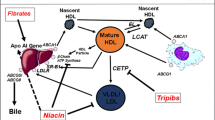Summary
Lipoprotein(a) combines structural elements of low. density lipoprotein (LDL) and plasminogen and is a strong independent risk factor for development of coronary heart disease (CHD). In 46 patients with primary hypercholesterolaemia, plasma lipoprotein(a) levels were highest in patients who had a history of coronary artery bypass graft surgery (700 ± 110 mg/L mean ±SEM), intermediate in those with CHD without bypass surgery (480 ± 80 mg/L) and lowest in those without CHD (350 ± 90 mg/L). 12 weeks’ treatment with 3-hydroxy-3-methylglutaryl-coenzyme A (HMG Co-A) reductase inhibitors, either pravastatin (20 to 40 mg/day; n = 22) or simvastatin (10 to 40 mg/day; n = 24), produced a 30% reduction in total plasma cholesterol (from 8.2 ± 1.1 to 5.7 ± 0.5 mmol/L, p < 0.01) and a 37% (p < 0.01) reduction in low density lipoprotein. Levels of apolipoprotein B and triglycerides also fell significantly (p < 0.01) and there was a significant rise (p < 0.05) in both HDL cholesterol and apolipoprotein A1. None of these variables changed in 6 patients randomised to receive placebo for 12 weeks. Lipoprotein(a) concentrations (475 ± 100 vs 490 ± 90 mg/L) did not change during treatment with pravastatin or simvastatin. The results of this study and other large scale clinical trials suggest that reduction of plasma LDL cholesterol by HMG Co-A reductase inhibitors, which act by upregulating LDL receptors, does not reduce this important risk factor in hyperlipidaemic patients.
Similar content being viewed by others
References
Berg K, Leren TP. Unchanged serum lipoprotein(a) concentrations with lovastatin. Lancet 2: 812, 1989
Brown G, Albers JJ, Fisher SM, Schaefer SM, Lin J-T, et al. Regression of coronary artery disease as a result of intensive lipid lowering therapy in men with high levels of apolipoprotein B. New England Journal of Medicine 323: 1289–1298, 1990
Canner PL, Berge KG, Wenger NK, Kromhout D, Barth JD, et al. Fifteen year mortality in Coronary Drug Project patients: long-term benefit with niacin. Journal of the American College of Cardiology 8: 1245–1255, 1986
Carlson LA, Hamsten A, Asplund A. Pronounced lowering of serum levels of lipoprotein LP(a) in hyperlipidaemic subjects treated with nicotinic acid. Journal of Internal Medicine 226: 271–276, 1989
Dahlen GH, Guyton JR, Attar M, Farmer JA, Kautz JA, et al. Association of levels of lipoprotein Lp(a), plasma lipids and other lipoproteins with coronary artery disease documented by angiography. Circulation 74: 758–765, 1986
Grundy SM. HMG-Co A reductase inhibitors for treatment of hypercholesterolaemia. New England Journal of Medicine 319: 24–39, 1988
Guraker A, Hoeg JM, Kostner G, Papadopoulos NM, Brewer Jr HB. Levels of lipoprotein (a) decline with neomycin and niacin treatment. Atherosclerosis 57: 293–301, 1985
Hajjar KA, Gavish D, Breslow JL, Nachman RL. Lipoprotein (a) modulation of endothelial cell surface fibrinolysis and its potential role in atherosclerosis. Nature 339: 303–305, 1989
Hoff HF, Beck GJ, Skibinski CI, Jürgens G, O’Neill J, et al. Serum Lp (a) levels as a predictor of vein graft stenosis after coronary artery bypass surgery in patients. Circulation 77: 1238–1244, 1988
Jurgens G, Ashy A, Zenker G. Raised serum lipoprotein (a) treatment during treatment with lovastatin. Lancet 1: 911–912, 1989
Kostner G, Klein G, Krempler F. Can serum Lp(a) concentrations be lowered by drug and/or diet? In Carlson & Olsson (Eds) Treatment of hyperlipoproteinaemia, pp. 151–156, Raven Press, New York, 1984
Masarei JRL, Rouse IL, Lynch WJ, Robertson K, Vandongen R, et al. Effect of a lacto-ovo vegetarian diet on serum concentrations of cholesterol, triglyceride, HDL-C, HDL2-C, HDL3-C, apoprotein B and LP(a). American Journal of Clinical Nutrition 40: 468–478, 1984
Miles LA, Fless GM, Levin EG, Scanu AM, Plow EF. A potential basis for the thrombotic risks associated with lipoprotein (a). Nature 339: 301–303, 1989
Mount JN, Kearney EM, Rosseneu M, Slavin BM. Immunoturbidimetric assays for serum apolipoproteins A1 and B using Cobas Bio centrifugal analyser. Journal of Clinical Pathology 41: 471–474, 1988
O′Connor P, Feely J, Shepherd J. Lipid lowering drugs. British Medical Journal 300: 667–672, 1990
Reihner E, Rudling MD, Stahlberg D, Berglund L, Ewerth S, et al. Influence of pravastatin, a specific inhibitor of HMG-CoA reductase, on hepatic metabolism of cholesterol. New England Journal of Medicine 323: 224–228, 1990
Reisen WF, Baur H, Beretta-Piccoli C, Fragiacomo C, Noseds G, et al. Increase of Lp(a) under therapy with HMG Co A reductase inhibitors. 55th European Atherosclerosis Society, 163A, Brugge, 17–19 May, 1990
Seed M, Hoppichler F, Reaveley D, McCarthy S, Thompson GR, et al. Relation of serum lipoprotein (a) concentrations and apolipoprotein (a) phenotype to coronary heart disease in patients with familial hypercholesterolaemia. New England Journal of Medicine 322: 1494–1499, 1990
Utermann G. The mysteries of lipoprotein (a). Science 246: 904–910, 1989
Wiklund O, Angelin B, Olofsson SO, Eriksson M, Fager G, et al. Apolipoprotein (a) and ischaemic heart disease in familial hypercholesterolaemia. Lancet 335: 1360–1363, 1990
Author information
Authors and Affiliations
Rights and permissions
About this article
Cite this article
O’Connor, P., Cooke, T. & Feely, J. Effects of HMG Co-A Reductase Inhibitors on Lipids and Lipoprotein(a) in Hypercholesterolaemia. Drug Invest 4, 227–231 (1992). https://doi.org/10.1007/BF03258403
Published:
Issue Date:
DOI: https://doi.org/10.1007/BF03258403




